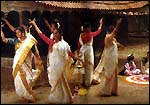

|
|
|
|
| HOME | TRAVEL | TRAVELOG | |||
 Onam Starts with Aththam
Onam Starts with Aththam
Shobha Warrier Sleepy Thripunithara, a little town in Kerala, the land of Onam... Come August and it's alive -- with preparations for the festival of the state. The 10-day celebrations commence on the Aththam day, when Keralites begin making pookkalam, a design of flowers. Every year, this little town, just 10 kilometres from Ernakulam, attracts thousands for the Aththaaghosham (the celebration of Aththam, the first day of Onam). It all began in the 12th century AD. The kula deivam or the clan deity of the then rulers was Thrikkakkara Appan, or Lord Vishnu. Lord Vishnu, the Onam legend goes, had himself incarnated as Vamana to defeat Mahabali, an asura king who was ruling Kerala. Mahabali's reign was one of peace and tranquility. There was no sorrow or unhappiness in his kingdom. There were no thieves or robbers. Only truth and happiness prevailed -- in fact, the situation was so perfect that the devas (gods) became jealous of him. The Vamana incarnation was to end Mahabali's heaven on earth. Vamana came to earth and asked three boons from Mahabali; and in the process sent him to the netherworld. The deva, however, granted that Mahabali could visit his kingdom once every year. Onam is that time, when the king visits his subjects. Interestingly, Keralites have dedicated Aththa chamayam, the predecessor of today's Aththaaghosham, to Vamana who so cruelly ended Mahabali's Utopian reign. At the Thrikkakkara temple, the festivities used to last for 28 days. Aththa chamayam, earlier, signified the king's ceremonious trip through the streets, dressed in his full regalia. He would be wearing a sequined turban, and his crown, believed to be set with jewels belonging to Lord Rama, would be on his lap. The royal pageant would be headed by members of the royal family, officials and soldiers. Afterwards, the king used to reward his subjects and officials, winding up the celebrations with a grand feast. On that day, the gates of the temple and the palace used to be thrown open to all faiths and castes, reflecting the Onam spirit: That all people are equal and all celebrate Onam the same way. After Independence, when the state of Cochin merged with Travancore, the Aththam celebrations had come to an end. However, it was later revived by popular committees as Aththaaghosham. Now, the royal character of the celebration is restricted to a lamp being lit by a member of the royal family. The pageant starts from a government school in Thirupunithara, winds its way through the streets, and ends at the point of origin in the afternoon. It has a band of pancha vadya players in front, followed by women wearing the Onam flag (a modern addition), girls with thalapoli, drums, masked mimes, various folk arts, and tableaux on several floats depicting scenes from the Puranas. On Atham, everything in Thripunithara passes on in a haze of happy confusion -- jam-packed buses, snarled traffic, noise, laughter... But no one minds. After all, it is Onam!
|
|
|
HOME |
NEWS |
BUSINESS |
CRICKET |
MOVIES |
CHAT
INFOTECH | TRAVEL | LIFE/STYLE | FREEDOM | FEEDBACK |
|